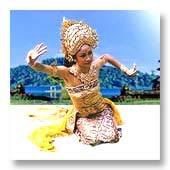The most important part of all Balinese ceremony is a Holy water. Holy water accompanies every act of Hindu-Balinese worship from individual devotion at household shrine to island-wide ceremonies. Holy water acts as an agent of the power of a God, a container of a mysterious force. It can be cleanse spiritual impurities, fend off evil forces, and render the recipient immune to the attacks of the negative, or demonic, influences. In Bali, holy water is not a symbol, it a material container of mystical power, and as such, is sacred and holy in and of itself. The holy water strengthens and purifies everything it touches. Although there are many kinds and potencies of holy water, no matter where or by whom it is made and no matter whether its quantity is great or small, holy water is always a sacred and powerful agent.
The Balinese call holy water toya, from medium Balinese word for “water,” and often the High Balinese tirtha will be used. These are never confused with ordinary water, however, which everyone calls by its low Balinese name, yeh. The uses and potency of holy water vary according to how it is made, its source, and who makes it. The more powerful the mantra and the more elaborate the offering use to make it, the more mystic energy it contains. The more sacred the place from which it is obtain, the greater the sanctity of the holy water. The more exalted the status of the person who makes it, the greater its magical power.
Holy water is use in many different ways and need not always be the most powerful variety. The supply kept in the several shrines of family temples need not come from as remote or high as source as, say, the holy water needed for cremation or temple festival. And sometimes holy water from specific temple may be preferred because that temple emphasizes a particular manifestation the Hindu deity and that manifestation is the one to whom an appeal is being made. All holy water is sacred but some kinds are more powerful, more appropriate in a given situation than others.
Holy water requires special handling, it must be treated with respect and deference. The most powerful holy water from the most sacred source, prepared with the most magical mantras and most elaborate offerings by most exalted priest loses its power if treated casually or disrespectfully. On the other hand, clean water from the well of a house compound placed in a new container in the shrine of an ordinary family temple becomes powerful and effective holy water if the feeling of the user toward it are properly reverent.
The holy water must be kept in a clean container and must be handled with great respect. People often use a bungbung – a section of bamboo culm closed at one end and open at the other – to transport holy water. Ordinary large glass jars, with loose-fitting glass top, are quite commonly use. Villager often transport holy water in ordinary drinking glasses or bottles. These should theoretically be brand new and unused. Typical red clay pot are often use for temporary storage in temples where demand for holy water.
Any container of holy water is always held and passed to others using only the right hand. The container should be held as high as possible as it is being handled, preferably higher than heads of others nearby. If placed on the floor, step over, or handled excessively, holy water will loose its mystical power and be rendered in effective. Containers of holy water are usually store in the shrines of family and public temples.
Holy water is so essential of Balinese life that it is impossible to list all its uses. Those who are sick are made well by balians or pamangkus or pedandas who clean the spirits of their patients with holy water. A Balinese undergoes such as cleansing before and after any major trip. Everyone of the rites of passage involves the use of holy water. Shrines are sprinkled with it everyday. Those who go in trance are bought back from this state with holy water.
And one of the most devastating things that can happen to a family is to be denied access to holy water from the village temples. This is a dreadful punishment for a person who has been expelled from his banjar because of failure to comply with the religious or customary laws. Because it is so serious, it is not a common punishment. It means, in effect, that the person so expelled is ritually dead. And this applies not only to him but also to all members of his family.
Most of the materials for this writing are taken from Fred B. Eiseman, Jr’s Bali Sekala and Niskala Volume I. (BALIwww)












